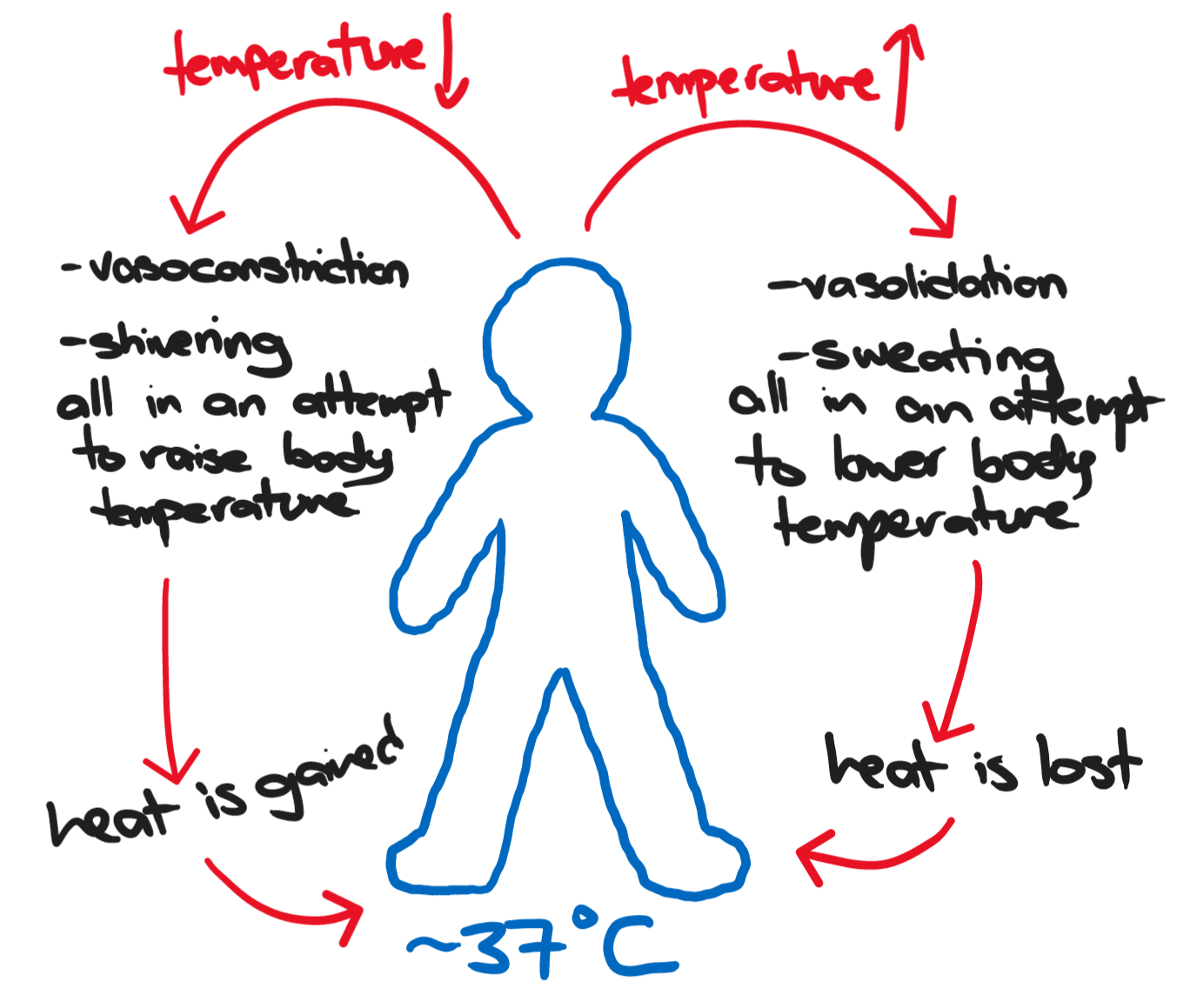
CIE A2 Biology 14.1: Homeostasis
Homeostasis is the process of organisms maintaining internal conditions at a constant value. Homeostasis is important to help an organism function at optimal levels all the time. Homeostatic mechanisms work by controlling the composition of blood, which controls the composition of tissue fluid. Examples of homeostasis include:
body temperature
lower temperatures slow down metabolic reactions; higher temperatures speed up metabolic reactions (see collision theory in chemistry)
however, higher temperatures risk the denaturation of enzymes
excretion
pH of blood and other parts of the body
if pH fluctuates outside its range, enzymes will denature
blood glucose/sugar levels
less glucose in the blood will slow down respiration; too much glucose will cause water to move out of a cell by osmosis
water potential of blood
less water will cause metabolic reactions to slow down or stop; more water may cause cell lysis (bursting)
concentration of respiratory gases in the blood
The Negative Feedback Loop
The negative feedback loop is a mechanism that is part of homeostasis. It works by returning conditions back to their normal parameters. It involves a receptor that is triggered when the body has too much of something.

Receptor: a cell or tissue that is sensitive to a specific stimulus and communicates with a control centre by generating nerve impulses or sending a chemical messenger
Effector: a tissue or organ that carries out an action in response to a stimulus; muscles and glands are common effectors
Stimulus: any change(s) in a factor that triggers a receptor
The receptors send signals as triggered by a stimulus through the nervous system to the spinal cord and/or brain. This is known as the input. The output is the chemical message generated from the information from the receptor that is given and carried out by the effector.
The most common negative feedback loops are corrective actions. They bring factors back to their set point.
Homeostasis in mammals works between different body parts. This includes body parts, the nervous system, and the endocrine system.
The nervous system passes information from receptors to effectors via electrical impulses along neurones
The endocrine system uses hormones as a form of long-distance cell signalling
Negative feedback is the only process in homeostasis that allows parameters to maintain their set point (with minor fluctuations). Positive feedback only increases a parameter in the direction of its change and thus, does not help keep body conditions constant.
Another Example of Homeostasis

CIE A2 Biology 14.1: Homeostasis
Homeostasis is the process of organisms maintaining internal conditions at a constant value. Homeostasis is important to help an organism function at optimal levels all the time. Homeostatic mechanisms work by controlling the composition of blood, which controls the composition of tissue fluid. Examples of homeostasis include:
body temperature
lower temperatures slow down metabolic reactions; higher temperatures speed up metabolic reactions (see collision theory in chemistry)
however, higher temperatures risk the denaturation of enzymes
excretion
pH of blood and other parts of the body
if pH fluctuates outside its range, enzymes will denature
blood glucose/sugar levels
less glucose in the blood will slow down respiration; too much glucose will cause water to move out of a cell by osmosis
water potential of blood
less water will cause metabolic reactions to slow down or stop; more water may cause cell lysis (bursting)
concentration of respiratory gases in the blood
The Negative Feedback Loop
The negative feedback loop is a mechanism that is part of homeostasis. It works by returning conditions back to their normal parameters. It involves a receptor that is triggered when the body has too much of something.

Receptor: a cell or tissue that is sensitive to a specific stimulus and communicates with a control centre by generating nerve impulses or sending a chemical messenger
Effector: a tissue or organ that carries out an action in response to a stimulus; muscles and glands are common effectors
Stimulus: any change(s) in a factor that triggers a receptor
The receptors send signals as triggered by a stimulus through the nervous system to the spinal cord and/or brain. This is known as the input. The output is the chemical message generated from the information from the receptor that is given and carried out by the effector.
The most common negative feedback loops are corrective actions. They bring factors back to their set point.
Homeostasis in mammals works between different body parts. This includes body parts, the nervous system, and the endocrine system.
The nervous system passes information from receptors to effectors via electrical impulses along neurones
The endocrine system uses hormones as a form of long-distance cell signalling
Negative feedback is the only process in homeostasis that allows parameters to maintain their set point (with minor fluctuations). Positive feedback only increases a parameter in the direction of its change and thus, does not help keep body conditions constant.
Another Example of Homeostasis

 Knowt
Knowt
